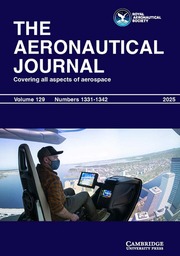No CrossRef data available.
Article contents
Design exploration of a ram-air-based heat exchanger system for disruptive engines
Published online by Cambridge University Press: 28 July 2025
Abstract
This study outlines design principles for a generic thermal management system (TMS) using a multi-design point approach. Four TMS configurations were analysed for a regional turboprop and short-haul type aircraft, focusing on total system gross power as an indicator of cost and environmental impact. Mechanisms were introduced to prevent coolant freezing. Results highlight the puller fan configuration as the most beneficial, leveraging temperature differentials and using the Meredith effect for increased operating capability. The ram-air configuration is slightly more efficient than the puller fan configuration for regional aircraft, but only for high system efficiencies and with operational constraints (taxiing in hot day conditions). Dual fan configurations offer significant thrust but also increased mass. The dual fan configuration shows comparable total system gross power to the puller fan for short-haul aircraft in cruise conditions, but not for regional aircraft. The pusher fan is not optimal for both aircraft types since the radiator significantly increases the heat exchanger inlet temperature, which results in higher drawbacks in terms of mass and total system gross power. In conclusion, the study emphasises the necessity to consider all relevant effects in the TMS design, such as drag, mass and efficiency, to allow the design of an optimal overall system.
Keywords
Information
- Type
- Research Article
- Information
- Copyright
- © The Author(s), 2025. Published by Cambridge University Press on behalf of Royal Aeronautical Society


